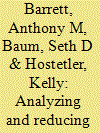| Srl | Item |
| 1 |
ID:
124855


|
|
|
|
|
| Publication |
2013.
|
| Summary/Abstract |
This article develops a mathematical modeling framework using fault trees and Poisson processes for analyzing the risks of inadvertent nuclear war from U.S. or Russian misinterpretation of false alarms in early warning systems, and for assessing the potential value of options to reduce the risks of inadvertent nuclear war. The model also uses publicly available information on early warning systems, near-miss incidents, and other factors to estimate probabilities of a U.S.-Russia crisis, the rates of false alarms, and the probabilities that leaders will launch missiles in response to a false alarm. The article discusses results, uncertainties, limitations, and policy implications.
|
|
|
|
|
|
|
|
|
|
|
|
|
|
|
|
| 2 |
ID:
151702


|
|
|
|
|
| Summary/Abstract |
Risk management is a decision-support process and a vital tool for military planning and decision-making. Today, several nations utilize risk-based approaches to analyze the level of security in military operations. There are both strengths and challenges in applying risk-based approaches to support military decisions. In this article, the challenges related to risk communication are investigated with the aim of describing how a military organization should train to create a good environment for effective risk communication. The analysis finds that it is important for the organization to define and consistently use a shared risk understanding. Such a shared risk understanding will need a systematic development process that focuses on the future decision makers’ and analysts’ education and training. To reach understanding, all involved parties must have the chance to identify the problem, reflect on its implications, test different solutions and develop a solution.
|
|
|
|
|
|
|
|
|
|
|
|
|
|
|
|